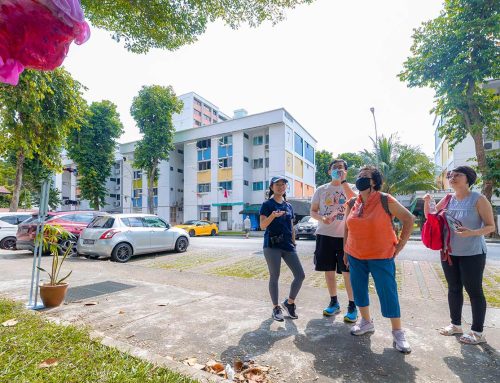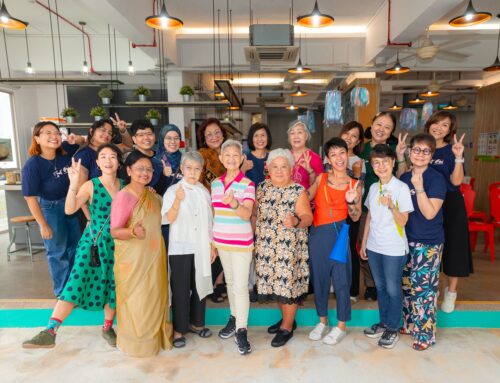Library / Project Journal
How to Cook Eight-Treasure Porridge
Library / Project Journal
How to Cook Eight-Treasure Porridge
By Salty Xi Jie Ng
26 February 2024
This post is part of a series on our Both Sides, Now project at Wellness Kampung @ 765 Nee Soon Central (2023-24). This year-long project aims to develop supportive communities for living well, and leaving well.
Both Sides, Now’s tides is slow-boiling a cosy eight-treasure porridge. In the last five months, we’ve forayed into several universes to conjure and birth eight collaborative projects, all of very different natures, each expressing a unique perspective toward living well, and leaving well. Casting myself back to when I was just getting to know the seniors, it’s moving to realise how much energy we’ve put into this pot together. Through intimate conversations that are long, short, planned and spontaneous, alongside group sessions, we got to know each other slowly — and as with any healthy relationship, takes time, trust, and authentic connection. In noting what is present in their lives, we locate together what truly matters to each of them — from existential questions to the struggles of caregiving. This is key to the development of projects that are true to their creators, sustained, and bring meaning to their makers and audiences.
The projects, all at different stages at the time of this reflection, have unfolded and ripened in their own ways. All these projects were realised with Assistant Artist Stacy Huang, who played different roles in each. Several projects have been made in collaboration with staff from Yishun Health, whose job scopes range from visiting residents for post-hospital nursing care to graphic design, and connecting residents to build community.
Recollection by Michelle Sim
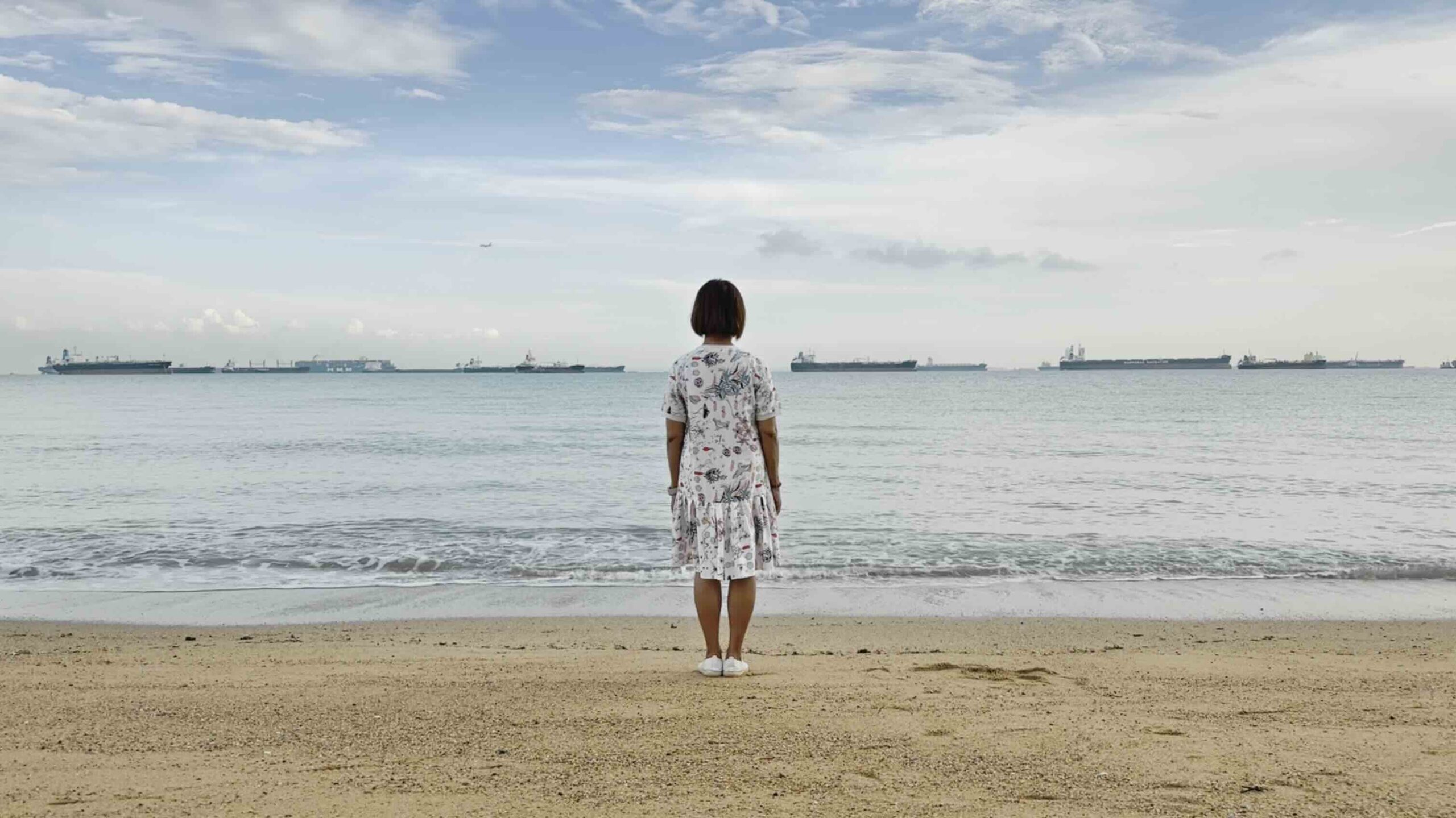
Film still from Recollection. Image by Salty Xi Jie Ng.
My first impression of Michelle, the youngest of the senior collaborators, was her harmonious nature and determined positivity. As we got to know each other, it became clear she was a storyteller, who collected never-ending anecdotes and stories as she moved about her rich everyday life, full of classes and volunteering to help other seniors. She would ponder the encounters that came to her, always striving to refine herself and the way she approached life and its challenges. One day during a group session, she shared a story about her friend whose husband had a sea burial. When she meets up with her friend, often at bodies of water, her friend would go to a corner to speak to her husband and tell him she was doing well. Inspired by that moving anecdote, I proposed making a short film sharing her stories and thoughts on life and death. After we recorded some of her anecdotes, I pieced a script together, which we edited. All the words she voice-overed were just as she had told them originally. One gloomy November evening, we went to different beaches in search of the sunset. As we chatted for almost three hours along the way, I had the distinct feeling that the film was, in some way, happening then, that it was her deeply poetic essence the film must capture — especially given her penchant, like many older women, to put herself down as less intelligent or important. Editing the film has been an emotional process as I connect with her profound inner world.
Feelings of a Dementia Caregiver by Magdalene Yap Choy Kam

The opening paragraph of Magdalene Yap Choy Kam’s letter to caregivers. Image by Salty Xi Jie Ng. Design by Putri Nada’Billah Binte Mohamad Hisham.
The most playful of the group, Magdalene is an immensely devoted full-time caregiver to her mother of over 90 years old. During one of our chats, I read her an open letter to caregivers written by a home care agency in Chicago. Sometime after, I invited her to pen her own. The result is a heartfelt, honest address sharing the ups and downs of caregiving, encouraging fellow caregivers, while acknowledging burnout and that sometimes, “We may not want the responsibility.” I took photos of her meticulously planned daily life with her mother, from 6am bedside exercises and blood pressure measurement to their afternoon RUMMIKUB game. All these were designed into a series of images by Yishun Health Community Care Associate Putri Nada’Billah Binte Mohamad Hisham, and will be displayed outside St. Luke’s Eldercare, a site where caregivers drop off their dependents daily. Accompanying this is Magdalene’s conversation circle where caregivers are invited to come together to share how their journeys have been unfolding.
Float Free by Chia Yim Fong, Koh Tong Cheng, and Michelle Sim

Behind-the-scenes in the production of Float Free. (from left) Sound recordist Glene Kan, Koh Tong Cheng, Chia Yim Fong, Michelle Sim, Salty Xi Jie Ng. Image by Stacy Huang.
One of the most astounding things I discovered early on was that three of the ladies in the project learned to swim at an old age. Notably, Tong Cheng, now 82 and the oldest of the group, persevered over multiple attempts at the age of 79, while Yim Fong avoided knee surgery and walking aids for ten years with the healing and relaxing powers of water. All of them had found a sense of community at Yishun Swimming Complex — only a few minutes walk from the Wellness Kampung— where many other ladies from the neighbourhood go for their morning swim. I proposed making a collaborative short film and they agreed. This has been the most major project of the lot, involving a long process of discussing each person’s unique arc, collecting quotes, piecing the script together, getting permission to film at the pool, rehearsing, looking for actors in the community (other Both Sides, Now seniors, Yishun Health staff, and Wellness Kampung ladies who swim at the pool), practising voice-overs, working with a sound recordist, sound designer, and colourist. The sound designer, Namira Rasman, has taught a singing and vocals class promoting healthy breathing at the Wellness Kampung for years — and all three of these ladies are devoted students. It was a wonderful opportunity to invite Namira to work with them on experimental vocals for a poetic underwater segment of the film; they bravely gave their all with much expression. Float Free is a playful amalgamation of three inspiring stories, intermingled with reflections on life and death.
From Atha to You by Devi Maniam

Devi’s granddaughter enjoying roti jala, with a message to her grandmother. Image by KumKrish Photography. Design by Lim Feng Ling.
Devi is an extremely loved matriarch and pillar of her family who often cooks for her children and grandchildren on the weekends. She would tell me about the dishes she cooks, like chicken rendang or sea bass soup, and what recipes her daughters had learnt. Like many older women, cooking is an act of love and service, while gathering over food is a ritual bringing the family together. Being so close to her grandchildren, we explored their favourite dishes of hers, and invited her four grandchildren to each write a message to her. She in turn penned them a moving message, gently declaring, “I will do your favourite dishes, cookies and kueh kueh. Atha will be there for you all always.” One of her daughters photographed her cooking and her grandkids eating mouthwatering roti jala with chicken curry. Designed by Yishun Health Senior Graphic Designer Lim Feng Ling, the result is a collage of images installed in the Wellness Kampung kitchen, bringing the legacy and warmth of one of its well-loved residents into a space both domestic and public.
Cord of Life by Agnes Tan

(from left) Agnes Tan, Stacy Huang and Fanny Hee working on Agnes’ sculptures. Image by Salty Xi Jie Ng.
In one of our group exploration sessions, I invited everyone to bring an important item they would like to pass down. To looks of amazement, Agnes brought two shrivelled remains of the umbilical cords that had once connected her with her daughters. How profound that the items she wants to pass down when she goes are what gave her daughters nourishment as they grew in her womb. Weeks later, as we were brainstorming Agnes’ project, the idea to make sculptures inspired by these umbilical cords emerged. We faced some hesitation about how it would be received, but assured folks that it would be made sensitively. Collaborating with Yishun Health Senior Staff Nurse Fanny Hee and Senior Healthcare Assistant Ji Yanli, who had previously worked in the childbirth department and the Intensive Care Unit, we would chat about life, death, rabbits, and more, as we worked on the sculptures, a process largely guided by Stacy. The result is five bright gems, like crystals dug out of an ancient cave, textured with chiffon pouffes and sparkles, to be hung from a tree aptly in communion with the organic. Stemming from Agnes’ curiosities, there will also be an intimate conversation circle discussing end-of-life goodbyes and conversations.
Single Seniors Club by Chia Yim Fong and Koh Tong Cheng

(from left) Chia Yim Fong, Agnes Low Si Ling, Koh Tong Cheng, and Marilyn Chan Min form the Single Seniors Club working group. Image by Salty Xi Jie Ng.
At our first group session, Yim Fong passionately raised her concerns as an elder living without family. She had read about single seniors dying alone at home and no one finding out for a period of time. It was one of her main catalysts for joining Both Sides, Now; an eternally curious being, she wanted to learn more about end-of-life planning. She was also concerned about how single seniors would buy food if ill, as well as social isolation — remarkably, she previously tried to organise her own gatherings for single seniors but found too many challenges to handle by herself. Tong Cheng, who lives alone, alerted everyone to a movement sensor installed for free in her apartment by Sengkang General Hospital. We discussed “good morning’s” in Whatsapp group chats as a way of single seniors notifying their peers or loved ones that they “had gotten out of bed that morning”. Thus began a little workgroup around the welfare and needs of single seniors. Spurred by Yim Fong’s interest in having discussions for single seniors about current affairs and social issues, we followed her to Toa Payoh Library for a regular public sharing and discussion by Lianhe Zaobao journalists for seniors. We formalised a workgroup with two Yishun Health staff and are discussing what it means to have a Single Seniors Club function as a peer support group. What profiles of single seniors are there, loosely speaking? Who do we want to reach, and how? What would a regular program at the Wellness Kampung look like? As we are exploring, Tong Cheng recently wrote an essay about her analysis of single senior profiles. The exhibition period will see the first session of the Single Seniors Club with the hope that it can continue at the Wellness Kampung with Yishun Health Senior Executive Marilyn Chan Min and Executive Agnes Low Si Ling supporting the seniors’ hopes and desires.
My Way by Shirley Wong Kwai Cheng
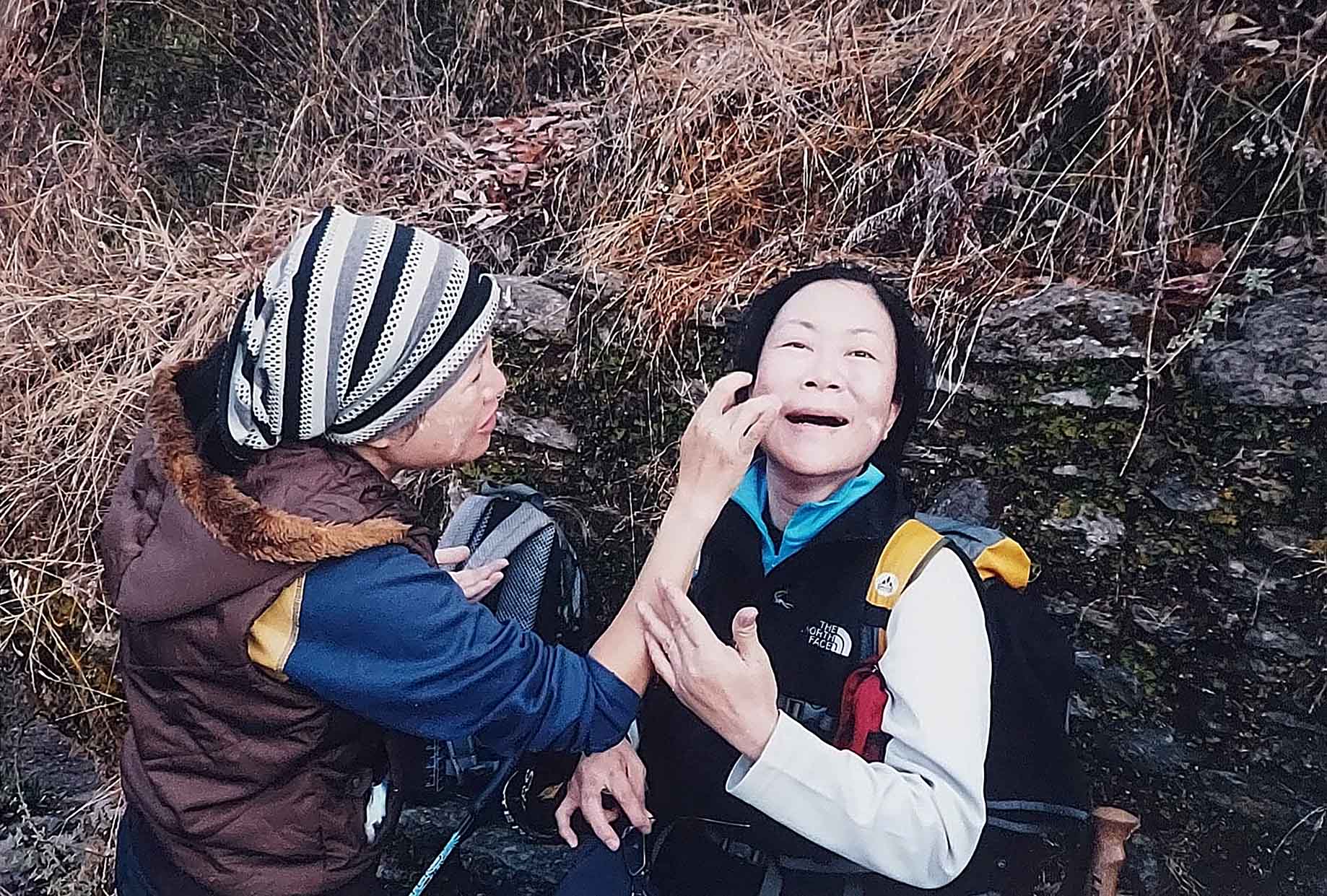
Shirley Wong Kwai Cheng’s sister applies sunblock on her face on a trek to Annapurna Base Camp, 2009. Image courtesy Shirley Wong Kwai Cheng.
Shirley has led an adventurous life with her husband, children and friends, trekking, snorkelling, and cycling around the world. Now, she wants to let everyone know how to celebrate the good memories when she is gone. In joining Both Sides, Now and engaging in an exploratory creative process, she chose to carve out time to make her end-of-life plans, something she has wanted to do for a while. In my mind’s eye, I keep seeing her telling me how happy she is to finally plan her funeral, and go through all her old photos. “This is the time to do it,” she says. Notably, she recently went through the process of doing a professional photoshoot to harvest an obituary photo, a celebratory experience turning out to be so much more, yielding over 700 raw images, a selection of which could be used for many purposes, conveying her different fun and elegant personas. Now, we are in the process of determining what is best kept private, for her loved ones only, and what is best shared with the public as her artwork expressing her end-of-life wishes and gratitude. How much should we provoke? What is best kept subtle? How can her brave act inspire others to allow themselves a similar process?
Who Can Tell Me? by Lim Soh Joo
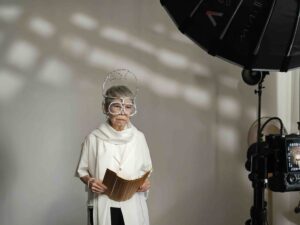
Behind the scenes in Lim Soh Joo’s photoshoot. Image by Stacy Huang.
Soh Joo’s concerns seemed markedly different from that of her peers. A single, easygoing senior with a relaxed lifestyle, she would share with me a multitude of questions about life, death, and the cosmos, some inspired by watching documentaries about ancient architecture. We made a list of all her questions such as “Why do I exist?” and “Why do we have to die?”, alongside those that pointedly ask, “Who can tell me?” and “Even if you do (know) one day, so what?” A few of her questions about outer space beings revealed similarities to the New Age movement. She was curious about what others could tell her about her queries, hence it was a natural step to create an installation with her many questions that would also function as a conversation booth, in the ethereal environment of the white void deck next to the Wellness Kampung. Together we researched and chose her costume and makeup, guided her in making her wire-and-foil headpiece, culminating in a photoshoot of the cosmic philosopher herself. The images will be presented alongside the booth, bringing her galactic presence to an everyday space. Soh Joo’s project contributes an existential yet gently whimsical perspective to the mix of more worldly concerns shared by her peers.
About Salty Xi Jie Ng

Salty Xi Jie Ng is the lead artist of Both Sides, Now 2023-24 at Wellness Kampung @ 765 Nee Soon Central. She is an artist and educator working intimately with people and their lives in relation with the other-than-human. The Grandma Reporter, her collaborative publication project about senior women’s culture across the earth, has explored style, intimacy and eroticism. She was commissioned by T:>Works Festival of Women N.O.W. to make Not Grey: Intimacy, Ageing and Being with elder Singaporean women.



